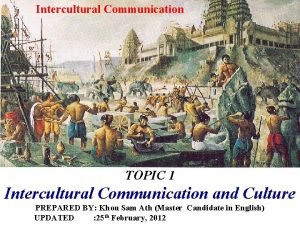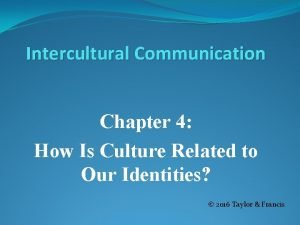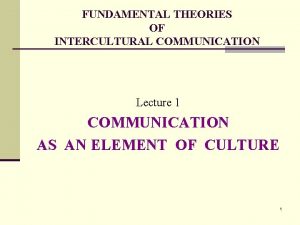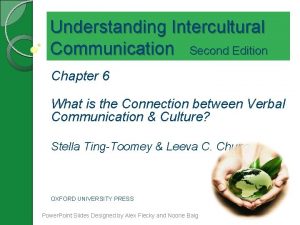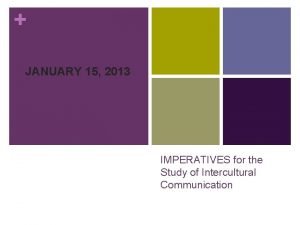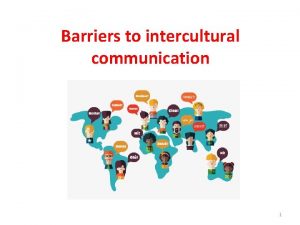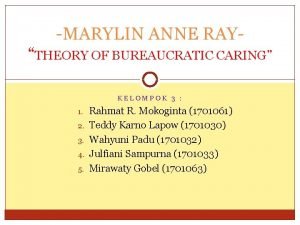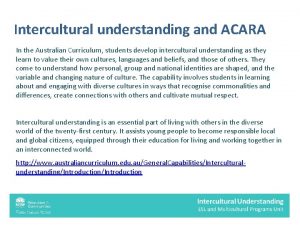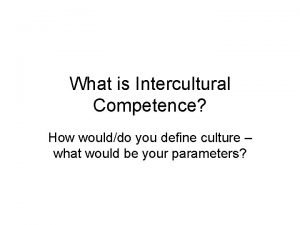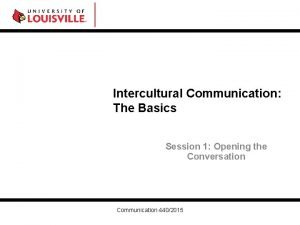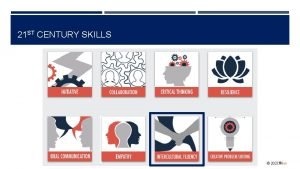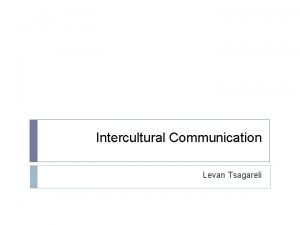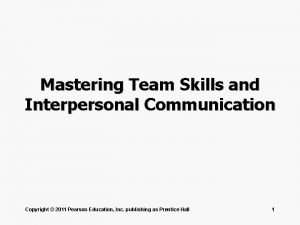Intercultural Communication Skills and the ESOL Teacher Marilyn






























































































































- Slides: 126

+ Intercultural Communication Skills and the ESOL Teacher Marilyn J. Rymniak – BDx Inter. Face LLC Spanish American Institute AUGUST 9, 2014 10: 00 a. m. – 1: 00 p. m.

+ 2 Workshop Description Intercultural Communication Skills and the ESOL Teacher This presentation will take a close look at why teachers of adult ESOL can benefit from intercultural communication skills training. The following topics will be covered in this training program: 1. Differences that impact classroom dynamics and effectiveness in the adult ESOL classroom. 2. Presentation of the Bennett Developmental Model of Intercultural Sensitivity (DMIS) and the acceptance, valuing and appreciation of difference. 3. The introduction of 3 other standard paradigms for understanding and comparing cultural differences: The Iceberg Theory, The Hall Model, Kohl’s Model. © 2014 MJ Rymniak BDx. Inter. Face LLC

+ 3 What this course is NOT! n It will NOT be a laundry list of cultural “DOs and DONTs” like the ones you might find in a tourist or travel book. These are usually too superficial or shallow, are often stereotypes and are often wrong or dated! (e. g. , “Don’t show a Saudi the soles of your feet. ”) They don’t really help you might for long-term relationships. n It will NOT change you overnight into a empathetic interculturalist. This will take time and requires incremental development along a continuum supplemented by actual interaction with those from other cultures. n It will NOT answer all your questions, nor will it stimulate all your questions. But it will give you some interesting academic and intellectual tools to begin finding the answers on your own or with your colleagues in the community. © 2014 MJ Rymniak BDx. Inter. Face LLC

+ 4 What is “Culture”? n How do we define it? n How does “culture” relate to “values”, “behaviors”, “beliefs”? n How many “levels” of culture exist? (national? , regional? , local? , individual? ) n What happens when cultures come in contact with each other? n How and how soon does one adjust to cultural differences? © 2014 MJ Rymniak BDx. Inter. Face LLC

+ Culture can be best expressed in the complex interactions of values, attitudes , and behavioral assumptions of a society. © 2014 MJ Rymniak BDx. Inter. Face LLC 5

6 © 2014 MJ Rymniak BDx. Inter. Face LLC

+ 7 Generalizations, Stereotypes, Perception We know that communication styles are patterns that people learn from the range of cultures in which they have membership. A “generalization” or “cultural norm” is the pattern of communication used by the majority of people in that cultural group. It is equally true to say that every culture has a “communication style norm” that is used by a majority of people in that culture and to say that a cultural norm is not likely to apply equally to every person in that culture. In other words, cultural norms can apply to most people in a group but do not apply to every individual in the group. When a cultural norm is applied to everyone in a group in a rigid manner, we have shifted from generalizations to stereotypes. Don’t be caught unconsciously stereotyping. Don’t automatically think one is stereotyping when they are simply making generalizations based on a cultural norm Perception is also highly susceptible to both personal and cultural experiences. © 2014 MJ Rymniak BDx. Inter. Face LLC

What do you see? © 2014 MJ Rymniak BDx. Inter. Face LLC 8

What do you see? © 2014 MJ Rymniak BDx. Inter. Face LLC 9

+ 10 Cultural Comparisons © 2014 MJ Rymniak BDx. Inter. Face LLC

11 Culture as an “Onion” Think of culture as an onion. Many, many layers make up an onion. Culture is similar, in that our values and behaviors have many different layers. Try drawing a mind map that describes your own layers of culture. 1. Inner layer: Cultural identity 2. Second layer: Race, gender, religion, ethnicity, social class, sexuality, age, mental and physical ability 3. Third layer: Communication, motivation, perceptions, attitudes, personality 4. Fourth layer: Occupation/career, religion, education, citizenship, generation (1 st, 2 nd, 3 rd), language, political ideology, region (province), urban/rural, immigrant status and age at immigration, majority/minority group membership. © 2014 MJ Rymniak BDx. Inter. Face LLC

+ 12 First Priority: Getting to Know Yourself as a Learner, a Person and a Cultural Being Analyze Yourself Using 1. Kolb’s Learning Styles Inventory (LSI) 2. The Keirsey Temperament Sorter/Myers-Briggs Type Indicator (MBTI) 3. Howard Sorter Gardner’s Multiple Intelligences (MI) 4. Barbe-Milone Perceptual Modality (PM) Checklist © 2014 MJ Rymniak BDx. Inter. Face LLC

+ 13 Kolb’s Four Styles of Learning Divergers – Reflective Observation Prefer to watch others play the game and figure it out for themselves before becoming involved – they solve problems through their own reasoning process usually by watching a demonstration by experts! FEEL and WATCH Assimilators – Abstract Conceptualization Prefer to learn the game by reading written instructions before attempting to play – they solve problems by inductive reasoning and are uncomfortable with random exploration! THINK and WATCH Convergers – Active Experimentation Prefer to participate in a well-controlled, simulated practice session – they solve problems by careful experimentation! THINK and DO Accommodators – Concrete Experience Prefer to jump in and just play, learning as they go – they solve problems by taking risks, preferring concrete experiences in which they just take action and see what happens! FEEL and DO © 2014 MJ Rymniak BDx. Inter. Face LLC

14 What’s Your Learning Style? © 2014 MJ Rymniak BDx. Inter. Face LLC

15 © 2014 MJ Rymniak BDx. Inter. Face LLC

16 © 2014 MJ Rymniak BDx. Inter. Face LLC

Gardner’s Multiple Intelligences © 2014 MJ Rymniak BDx. Inter. Face LLC 17

18 Another way of looking at Gardner… in case you are visual. © 2014 MJ Rymniak BDx. Inter. Face LLC

19 © 2014 MJ Rymniak BDx. Inter. Face LLC

20 Don’t take it too far! © 2014 MJ Rymniak BDx. Inter. Face LLC

+ Dealing With Difference n Our initial response to difference is to avoid it. This is normal. Fight or Flight. Isolationism. n Or we try to convert the “different” group to our way of thinking. Imposing our beliefs, customs on others. Assimilation. Acculturation. n Or we simply get rid of “the other”. Separate them from us. Make their lives unbearable to live among us. Bullying, Genocide, Ethnic Cleansing, Geographic Isolation, Reservations. © 2014 MJ Rymniak BDx. Inter. Face LLC 21

+ 22 Intercultural Communication is set in Cultural Relativity © 2014 MJ Rymniak BDx. Inter. Face LLC

23 © 2014 MJ Rymniak BDx. Inter. Face LLC

24 © 2014 MJ Rymniak BDx. Inter. Face LLC

25 © 2014 MJ Rymniak BDx. Inter. Face LLC

+ 26 Valuing DIVERSITY © 2014 MJ Rymniak BDx. Inter. Face LLC

+ 27 Appreciating DIFFERENCE © 2014 MJ Rymniak BDx. Inter. Face LLC

+ 28 Difference n. How Comfortable Are You With It? n. What categories of difference do you find in the adult ESOL classroom? © 2014 MJ Rymniak BDx. Inter. Face LLC

What categories of difference are we already “used to” seeing in an adult ESOL class? • • • • • • age gender culture geographic origin language dress look life experiences socio-economic level social class ethnicity professional/vocational family configurations abilities disabilities lifestyle choices sexual orientation religious beliefs values generational learning styles personality traits … even MAC vs. PC preference! © 2014 MJ Rymniak BDx. Inter. Face LLC 29

+ Dealing with difference is NOT a natural human capability. It is insufficient to just say “let’s be different”. It goes against natural inclinations. © 2014 MJ Rymniak BDx. Inter. Face LLC 30

31 © 2014 MJ Rymniak BDx. Inter. Face LLC

32 The Golden Rule © 2014 MJ Rymniak BDx. Inter. Face LLC

+ 33 The Golden Rule = Sympathy n The Golden Rule: (Abridged) Treat other people the way you would like to be treated yourself n to understand another person by imagining yourself in his or her position. n The Golden Rule (Abridged) and its communication strategy, Sympathy, are based on the assumption of similarity. n We need to overcome the Golden Rule and convert it to the Platinum Rule. © 2014 MJ Rymniak BDx. Inter. Face LLC

34 © 2014 MJ Rymniak BDx. Inter. Face LLC

The Platinum Rule © 2014 MJ Rymniak BDx. Inter. Face LLC 35

+ 36 Overcoming the Golden Rule = Empathy n The Platinum Rule: Treat other people the way they want to be treated (or at least be aware of what that is). n Empathy: The attempt to understand another person by imagining his or her perspective, n The Platinum Rule and its communication strategy, Empathy, are based on the assumption of difference. © 2014 MJ Rymniak BDx. Inter. Face LLC

37 © 2014 MJ Rymniak BDx. Inter. Face LLC

+ 38 Sympathy vs. Empathy The attempt to understand another person by imagining yourself in his or her position vs. The attempt to understand another person by imagining his or her perspective. © 2014 MJ Rymniak BDx. Inter. Face LLC

+ 39 The Lead Rule = The Lead Rule Treat other people the way they deserve to be treated. © 2014 MJ Rymniak BDx. Inter. Face LLC

+ A Developmental Model A developmental model addresses the question of how do people naturally react to difference. © 2014 MJ Rymniak BDx. Inter. Face LLC 40

+ 41 A Developmental Model Displays a continuum with “ethnocentrism” at the beginning point and “ethno-relativism” at the end point. © 2014 MJ Rymniak BDx. Inter. Face LLC

+ 42 Ethnocentrism n Your view of reality, your worldview, is intrinsically more real. n Your culture is central to reality. n Your way is more natural – makes more sense. © 2014 MJ Rymniak BDx. Inter. Face LLC

+ 43 Ethnorelativism n Idea of seeing things as relative. n Culture as relative to one another. n Interpreting events in the context of culture. © 2014 MJ Rymniak BDx. Inter. Face LLC

+ Dr. Milton J. Bennett: “A Developmental Model of Intercultural Sensitivity”, 1986 n The Bennett scale, also called the DMIS (for Developmental Model of Intercultural Sensitivity), was developed by Dr. Milton Bennett of the Intercultural Communication Institute in Portland, Oregon. n The framework describes the different ways in which people can react to cultural differences. © 2014 MJ Rymniak BDx. Inter. Face LLC 44

+ 45 Bennett’s Developmental Model of Intercultural Sensitivity (DMIS) © 2014 MJ Rymniak BDx. Inter. Face LLC

Think of How Each Country Presents the Map of the World – Most are ethnocentric! © 2014 MJ Rymniak BDx. Inter. Face LLC 46

+ 47 Ethnocentric State # 1: Denial of Difference n No recognition of cultural difference because of isolation or intentional separation. Attribution of deficiency in intelligence or personality to culturally deviant behavior. Tendency to dehumanize outsiders. n Issues in Denial indicate that you are comfortable with the familiar and are not anxious to complicate life with “cultural difference”. You may simply just notice much cultural difference around you. For instance: n In general, you may be unaware of a significant minority population in your area or you may be disinterested in multicultural or international affairs that do not immediately affect you or your family or your close circle of friends. © 2014 MJ Rymniak BDx. Inter. Face LLC

+ 48 Ethnocentric State # 1: Denial of Difference n In general, you may be unaware of a significant minority population in your area or you may be disinterested in multicultural or international affairs that do not immediately affect you or your family or your close circle of friends. n As a visitor in another country, you may spend most of your time concerned with the familiar categories of food, clothing, and money, instead of exploring the less-familiar idea of cultural differences. n In business situations, you may be so intent on the tasks at hand that you do notice much about the cultural aspects of business relationships with clients and coworkers. n In educational settings, you may be unaware of and uninterested in the effects of cultural difference of teaching and learning. © 2014 MJ Rymniak BDx. Inter. Face LLC

+ 49 Ethnocentric State # 2: Defense Against Difference n Recognition of cultural difference coupled with negative evaluation of most variations from native culture – the greater the difference, the more negative the evaluation. Evolutionary view of cultural development with native culture at the acme. A tendency towards social/cultural proselytizing of “underdeveloped” cultures. n Issues in Defense indicate that you have a strong commitment to your own worldview and some distrust of cultural behavior or ideas that differ from your own. You are aware of other cultures around you, but you may have a relatively incomplete understanding of them and you probably have fairly strong negative stereotypes about some of them. For instance: n You may routinely refer to people of other cultures as “them” or “you people” and you might be particularly attentive to negative qualities attributed to other groups. © 2014 MJ Rymniak BDx. Inter. Face LLC

+ 50 Ethnocentric State # 2: Defense Against Difference n You may routinely refer to people of other cultures as “them” or “you people” and you might be particularly attentive to negative qualities attributed to other groups. n You might belong to or sympathize with groups that stress the superiority of your own culture. n As an educator or student, you may focus exclusively on traditional subjects and be dismissive of any non-traditional learning. n As a manager or educator, you are likely to feel that cultural adjustment is entirely the responsibility of people who choose to move from their own cultural group into a different group. n If you travel or live abroad, you may find yourself complaining quite a bit about the failings of your hosts. © 2014 MJ Rymniak BDx. Inter. Face LLC

+ 51 Ethnocentric State # 2 b: Reversal n Tendency to see another culture as superior while denigrating one’s own. n Issues in Reversal indicate that you have a largely positive view of an adopted culture or other cultures in general and a somewhat negative opinion of your own. However, your understanding of the adopted culture may be based on positive stereotypes. For instance: n You may be a current or former cross-cultural volunteer (e. g. , Peace Corps, Vista, Americorps, etc. ) who has “adopted” an idealized version of the culture to which you were assigned. In doing so, you may have also adopted some of their negative stereotypes of your own culture. © 2014 MJ Rymniak BDx. Inter. Face LLC

+ 52 Ethnocentric State # 2 b: Reversal n You may be a current or former cross-cultural volunteer (e. g. , Peace Corps, Vista, Americorps, etc. ) who has “adopted” an idealized version of the culture to which you were assigned. In doing so, you may have also adopted some of their negative stereotypes of your own culture. n If you are a long-term expatriate manager in a global corporation, you may have developed a cynical view of your own culture that passes for sophistication in many international circles. n As a member of a dominant ethnic group who is concerned with ethnic oppression, you may have disavowed your own ethnic roots in favor of being “one with” members of the oppressed group. © 2014 MJ Rymniak BDx. Inter. Face LLC

+ 53 Ethnocentric State # 3: Minimization of Difference n Recognition and acceptance of superficial differences such as eating customs, etc. While holding that all human beings are essentially the same. Emphasis on the similarity and commonality of basic values. Tendency to define the basis of commonality in ethnocentric terms (i. e. , everyone is essentially like us, like me). n Physical Universalism: Emphasis on commonality of human beings in terms of physiological or biological similarity. n Transcendent Universalism: Emphasis on commonality of human beings as subordinate to a particular supernatural being (e. g. , ”All God’s Children” idea), religion, or social philosophy (e. g. , Marxian Economics) © 2014 MJ Rymniak BDx. Inter. Face LLC

+ 54 Ethnocentric State # 3: Minimization of Difference n Issues in Minimization indicate that you have gotten beyond feeling that other cultures pose a threat to your own. Your experience is that people from other cultures are pretty much like you, under the surface. You are quite aware that other cultures exist all around you, and you may know something about cultural differences in customs, celebrations, etc. You do not denigrate other cultures and you seek to avoid stereotypes by treating every person as an individual or by treating other people as you would like to be treated (sympathy). For instance: n You may offer to be a host family for a foreign student, or volunteer for international programs, with the motivation that it will be fun and you can help the visitors understand the ways of your own culture. © 2014 MJ Rymniak BDx. Inter. Face LLC

+ 55 Ethnorelative State # 1: Acceptance of Difference n Recognition and appreciation of cultural differences in behavior and values. Acceptance of cultural differences as viable alternative solutions to the organization of human existence. Cultural relativity. n Resolved issues in Acceptance indicate that you both acknowledge and respect cultural difference. You are aware of your own culture (s), and you see that your own culture is just one of many ways of experiencing the world. When you think of people from other cultures, you imagine them as every bit as complex as yourself. Their ideas, feelings and behavior may seem unusual to you, but you realize that their experience is just as rich as your own. You may not like everything about other cultures (or everything about your own for that matter), but that fact does not make you think that any cultural group is more or less “civilized”. You are curious about other cultures and seek opportunities to learn more about them, even if you do not have opportunities to interact with members of those cultures. For instance: © 2014 MJ Rymniak BDx. Inter. Face LLC

+ 56 Ethnorelative State # 1: Acceptance of Difference n As a manager or administrator, you probably recognize the value of global and domestic diversity in organizations. However, you may not be considering how you and the organization need to change to accommodate the diversity. n In educational settings, you are likely to support efforts to diversify the curriculum to be more representative of a broad range of cultural perspectives. n If you are traveling or living in other cultures, you may not act any differently than you do with members of your own culture. But you are probably aware that your behavior might be interpreted in unusual ways. You in turn are probably careful to withhold quick judgments of members of other cultures and to consider how their behavior might mean something different than it would in your own culture. © 2014 MJ Rymniak BDx. Inter. Face LLC

+ 57 Ethnorelative State # 2: Adaptation to Difference Cognitive Frame-Shifting n The development of communication skills that enable intercultural communication. Effective use of empathy, or frame of reference shifting, to understand be understood across cultural boundaries. n Resolved issues in the Cognitive Frame-Shifting form of Adaptation indicate that you recognize the added value of having more than one cultural perspective available to you. Further, you are able to “take the perspective” of another culture for the purpose of understanding or evaluating situations in either your own or another culture. For instance: © 2014 MJ Rymniak BDx. Inter. Face LLC

+ 58 Ethnorelative State # 2: Adaptation to Difference Cognitive Frame-Shifting n You may know enough about your own and at least one other culture to shift substantially into the other cultural frame of reference. You are likely to add this perspective to discussions about “how things work. ” n As a manager, teacher, administrator, you may routinely use your frame-shifting ability to act as a “bridge” between people of two different cultures for conflict resolution coordination of understanding. You become the mediator. n In business, you are probably skeptical of training that touts the one best way of communicating, marketing, or relating to others. You know that all such behavior occurs in cultural contexts. © 2014 MJ Rymniak BDx. Inter. Face LLC

+ 59 Ethnorelative State # 3: Integration of Difference Adaptation Behavioral Code-Shifting n The internalization of bi-cultural or multi-cultural frames of reference. Maintaining a definition of identity that is “marginal” to any particular culture. n Resolved issues in the Behavioral Code-Shifting form of Adaptation indicate that you are able to intentionally change your culturally based behavior. You have a broad repertoire of behavior that allows you to act in culturally appropriate ways outside your own culture. For instance: n When you shift into the frame of another culture, you find that your behavior changes in a natural way to express that different view of the world. In other words, you can feel when and what different behavior is appropriate. You also may be able to intentionally change your behavior to match that of another culture, even if you are not around people from that culture. © 2014 MJ Rymniak BDx. Inter. Face LLC

+ 60 Ethnorelative State # 3: Integration of Difference Adaptation Behavioral Code-Shifting n When you shift into the frame of another culture, you find that your behavior changes in a natural way to express that different view of the world. In other words, you can feel when and what different behavior is appropriate. You also may be able to intentionally change your behavior to match that of another culture, even if you are not around people from that culture. n As a business person, you are likely to be accomplished in negotiation across cultures or managing multicultural teams. You may often find yourself facilitating intercultural discussions. n In organizations, you are likely to recognize that global and domestic diversity demands constant adaptation and that policies must reflect that need. You are probably a proponent for organizational development along these lines. n As an educator, you may actually teach from a variety of cultural perspectives. That is, you do not simply teach about other cultural perspectives – you are able to embody them, to some degree. © 2014 MJ Rymniak BDx. Inter. Face LLC

+ 61 Ethnorelative State # 3 b: Encapsulated Marginality n Issues in Encapsulated Marginality indicate that you are struggling with how to integrate your intercultural abilities with your identity. You may be asking yourself, “Now that I can shift my cultural perspective and behavior whenever I want, who am I anyway? ” This condition is a transition between Adaptation and Integration (Constructive Marginality), where you are more likely to say “Who I am is a person who can move easily among cultures. ” But at this point, you are probably feeling some alienation from all the cultures you know about, including your own. For instance: n As a traditional-age or returning-adult student, you may have trouble making decisions about what to study, since everything seems equally interesting and important to one of the many careers that you are considering. © 2014 MJ Rymniak BDx. Inter. Face LLC

+ 62 Ethnorelative State # 3 b: Encapsulated Marginality n If you are returning from a long sojourn abroad and have developed an Adaptation worldview, you may experience this sense of alienation associated with re-entry into your original culture. n In business situations, you may find yourself feeling separate from your coworkers and unable to identify with either the corporate culture or any of the national/ethnic cultures of which you may be a part. n Although less likely, your sense of alienation may be associated with Reversal, because you are rejecting your own culture but do not have the depth in another culture to support a clear identity. n Military Brats, Third Culture Kids, , long-term expats……. etc. © 2014 MJ Rymniak BDx. Inter. Face LLC

+ 63 The Iceberg Theory of Culture n CULTURE (with a big “C”) = primarily in awareness 10% § culture (with a little “c”) = primarily out of awareness 90% © 2014 MJ Rymniak BDx. Inter. Face LLC

64 Hall’s Iceberg Theory of Culture The Comparative Study of Values © 2014 MJ Rymniak BDx. Inter. Face LLC

+ 65 The Iceberg Paradigm n Cultural differences are not always noticeable. The Iceberg Theory of Culture (perhaps a Freudian Theory) says that only 10% of any country’s culture is readily noticeable as experienced through our senses – the food, the dress, the music, the physical look, the language, the literature. n This is all part of “Culture” with a “Capital C”. It is the part of culture that is in our consciousness. It is the part of culture that we can hear, see, smell, touch and taste. It is in our primary awareness. n This part of culture rarely causes conflict – you either eat the food or you don’t, listen to the music or not. You have a choice whether to interact or not with these aspects of the culture because you are consciously aware of them. © 2014 MJ Rymniak BDx. Inter. Face LLC

+ 66 How do you define “Culture” anyway? What does it mean if I say “I love the Italian culture!”? © 2014 MJ Rymniak BDx. Inter. Face LLC

+ It could mean many different things, like … I love the food! I love the language! I love opera! I love Rome! © 2014 MJ Rymniak BDx. Inter. Face LLC I love Fellini Films! 67

+ Or, it might simply mean “I love the men!” © 2014 MJ Rymniak BDx. Inter. Face LLC 68

+ … and the women! © 2014 MJ Rymniak BDx. Inter. Face LLC 69

70 © 2014 MJ Rymniak BDx. Inter. Face LLC

+ 71 Above and Below the Line n Actions or superficial public behavior is cultural in origin, and yet we adopt these manners without prejudice to our own core beliefs. (e. g. , use of a fork and knife when eating). n Actions are not difficult to emulate, and even different varieties of speech can be imitated to some extent. Thought and values are different. n We cannot see “thought”; we cannot hear it; it may be revealed to us with reluctance, simulation or cunning. n Cross-cultural problems arise not so much on account of our unfamiliarity with a bow, a Gallic shrug or chopsticks (all above the iceberg waterline) but in the importance and interpretation we place on certain values. © 2014 MJ Rymniak BDx. Inter. Face LLC

+ 72 Below the Waterline n The 90% of the culture that is below the proverbial “waterline” is out of our conscious awareness. n But it is this part of the culture that represents the true culture of any country. n Until you have lived in another culture or among people of a different culture than the one you were brought up in, you cannot understand the difference. n You need to experience the culture on a day-to-day basis and interact with natives of that culture to become familiar with the aspects of the culture below the waterline. © 2014 MJ Rymniak BDx. Inter. Face LLC

73 © 2014 MJ Rymniak BDx. Inter. Face LLC

+ 74 “Tip-of-the-Iceberg Culture” is anything you can perceive with your five senses n Language n Architecture n Food n Population n Music n Clothing n Art and Literature n Pace of Life n Emotional Display n Gestures n Leisure Activities n Sports n Eating Utensils n Folk Dancing n Games © 2014 MJ Rymniak BDx. Inter. Face LLC

+ 75 “Bottom-of-the-iceberg” values determine: n Notions of time n How the individual fits into society n Beliefs about human nature n Notions about adolescence n Importance of work – worth ethic n Roles of adults and children in the family n Ideals governing child raising n Body language/Eye language n Importance of saving face, harmony n Communication styles n Attitudes toward men’s and women’s roles in society n Thinking styles –linear or systemic n Notions of modesty n Concepts of beauty and cleanliness n Courtship practices n Definition of sickness and insanity n … and many more © 2014 MJ Rymniak BDx. Inter. Face LLC

76 © 2014 MJ Rymniak BDx. Inter. Face LLC

77 © 2014 MJ Rymniak BDx. Inter. Face LLC

+ 78 Edward Hall’s Model Low Context Culture High Context Culture © 2014 MJ Rymniak BDx. Inter. Face LLC

79 © 2014 MJ Rymniak BDx. Inter. Face LLC

+ 80 Low vs. High Context Cultures n Edward T. Hall, considered by many to be the father of intercultural communication studies (he was the first to use the term), developed in his book, Beyond Culture (1976) an interesting paradigm for looking at different cultures. n Hall said that you could plot cultures along a continuum to determine how important precise words were for conveying real meaning as opposed to how important the context or situation in which you said these words is. n In Low Context Cultures (like Germanic and Scandinavian cultures), verbal instructions must be precise and able to stand on their own regardless of who says them or where or how they are said. © 2014 MJ Rymniak BDx. Inter. Face LLC

Father of American Proxemics © 2014 MJ Rymniak BDx. Inter. Face LLC 81

+ Hall’s High/Low Context Model High context n In a high-context culture, there are many contextual elements that help people to understand the rules. As a result, much is taken for granted. This can be very confusing for a person who does not understand the 'unwritten rules' of the culture. Low context n In a low-context culture, very little is taken for granted. Whilst this means that more explanation is needed, it also means there is less chance of misunderstanding particularly when visitors are present. Contrasting the two n French contracts tend to be short (in physical length, not time duration) as much of the information is available within the high-context French culture. American content, on the other hand, is low-context and so contracts tend to be longer in order to explain the detail. n Highly mobile environments where people come and go need lower-context culture. With a stable population, however, a higher context culture may develop. © 2014 MJ Rymniak BDx. Inter. Face LLC 82

+ 83 Time Monochronic (M) Time n M-Time, as Hall called it, means doing one thing at a time. It assumes careful planning and scheduling and is a familiar Western approach that appears in disciplines such as 'time management'. n Monochronic people tend also to be low context. Polychronic (P) Time n In Polychronic cultures, human interaction is valued over time and material things, leading to a lesser concern for 'getting things done' -- they do get done, but more in their own time. n Aboriginal and Native Americans have typical polychronic cultures, where 'talking stick' meetings can go on for as long as somebody has something to say. n Polychronic people tend also to be high context. © 2014 MJ Rymniak BDx. Inter. Face LLC

+ 84 Time Contrasting the Two n Western cultures vary in their focus on monochronic or polychronic time. Americans are strongly monochronic whilst the French have a much greater polychronic tendency – thus a French person may turn up to a meeting late and think nothing of it (much to the annoyance of a German or American co-worker). © 2014 MJ Rymniak BDx. Inter. Face LLC

+ 85 Monchronic People n n n do one thing at a time concentrate on the job compartmentalize tasks are low-context and need information are committed to the job adhere religiously to plans are concerned about not disturbing others; follow rules of privacy and consideration show great respect for private property seldom borrow or lend emphasize promptness are accustomed to short-term relationships © 2014 MJ Rymniak BDx. Inter. Face LLC

+ 86 Polychronic People n n n do many things at once are highly distractible and subject to interruptions rarely compartmentalize consider time commitments an objective to be achieved, if possible are high-context and already have information are committed to people and human relationships change plans often, easily and spontaneously are more concerned with those who are closely related (family, friends, close business associates) than with privacy) borrow and lend things often and easily and for long periods of time base promptness on the relationship have strong tendency to build lifetime relationships © 2014 MJ Rymniak BDx. Inter. Face LLC

87 © 2014 MJ Rymniak BDx. Inter. Face LLC

+ 88 Space n Hall was concerned about space and our relationships within it. He called the study of such space Proxemics. We have concerns about space in many situations, from personal body space to space in the office, parking space, space at home. n The need for space: Some people need more space in all areas. People who encroach into that space are seen as a threat. Personal space is an example of a mobile form of territory and people need less or greater distances between them and others. A Japanese person who needs less space thus will stand closer to an American, inadvertently making the American uncomfortable. n Some people need bigger homes, bigger cars, bigger offices and so on. This may be driven by cultural factors, for example the space in America needs to greater use of space, whilst Japanese need less space (partly as a result of limited useful space in Japan). © 2014 MJ Rymniak BDx. Inter. Face LLC

+ 89 Space High Territoriality n Some people are more territorial than others with greater concern for ownership. They seek to mark out the areas which are theirs and perhaps having boundary wars with neighbors. This happens right down to desk-level, where co-workers may do battle over a piece of paper which overlaps from one person's area to another. n At the national level, many wars have been fought over boundaries. Territoriality also extends to anything that is 'mine' and ownership concerns extend to material things. Security thus becomes a subject of great concern for people with a high need for ownership. People with high territoriality tend also to be low context. © 2014 MJ Rymniak BDx. Inter. Face LLC

+ 90 Space Low Territoriality n People with lower territoriality have less ownership of space and boundaries are less important to them. They will share territory and ownership with little thought. They also have less concern for material ownership and their sense of 'stealing' is less developed (this is more important for highly territorial people). n People with low territoriality tend also to be high context. Contrasting n Australian Aboriginal people will say that they belong to the land rather than the other way around. Before we scotch this, we should remember that they have thrived in harsh conditions for thousands of years. © 2014 MJ Rymniak BDx. Inter. Face LLC

+ 91 Space Low Territoriality n Western society, on the other hand has shown much barbarity over ownership of land. So what? n When working across cultures, pay attention to high and low Hall's cultural factors cultures through the actions of others. For example if people are late for meetings it may be because they are polychronic, not because they are disrespectful or lazy. n When you understand the personal, national or organizational culture, then you can seek to align with them and hence gain greater influence. © 2014 MJ Rymniak BDx. Inter. Face LLC

+ 92 Low vs. High Context Cultures n In High Context Cultures (like Japanese, Arabic and Persian Cultures) the words themselves are not as important as the context in which they are said, which may include who is saying them, who else is present, what emotions are displayed, where the words are being spoken. n In a High Context Culture, the same words may mean very different things depending on the context in which they are spoken. n Americans are more Low Context than High – this is why we have so many lawyers – because we feel the words themselves must be precise. n The saying “a man is only as good as his word” is a Low Context philosophy. © 2014 MJ Rymniak BDx. Inter. Face LLC

+ 93 The Hall Model High Context French Canadian Japanese English Chinese English Canadian Arab American (USA) Greek Scandinavian Mexican German Spanish Dutch Italian German Swiss French Low Context © 2014 MJ Rymniak BDx. Inter. Face LLC

+ 94 Kohl’s Model American Values Other Values © 2014 MJ Rymniak BDx. Inter. Face LLC

+ 95 US Values vs. Other Country’s Values n Robert Kohl’s Model attempts to explain the basic values of mainstream Americans by placing them on a continuum of what he calls “Other Country’s” values. n Foreign visitors or immigrants new to the USA are often surprised at how Americans often seem to neglect to build relationships before doing business with someone. n Americans seem to jump right in and make quick decisions rather than spending time talking small talk to get to know the other person. This is because mainstream Americans have a need to control time. n This is sometimes done at the expense of building the relationship in order to keep on schedule. This is a very simple model and it deals in bell-shaped curve generalities. , so one must be careful not to fall into the trap of developing stereotypes from these. © 2014 MJ Rymniak BDx. Inter. Face LLC

US Values Some Other Country’s Values Personal Control over the Environment/Responsibility Fate/Destiny Change seen as natural and positive Stability/Tradition/Continuity Time and its Control Human Interaction Equality/Fairness Hierarch/Rank/Status Individualism/Independence Group’s Welfare/Dependence Self-Help/Initiative Birthright Inheritance Competition Cooperation Future Orientation Past Orientation Action/Work Orientation “Being” Orientation Informality Formality Directness/Openness/Honesty Indirectness/Ritual/”Face” Practicality/Efficiency Idealism/Theory Materialism/Acquisitiveness Spiritualism/Detachment © 2014 MJ Rymniak BDx. Inter. Face LLC 96

+ 97 What Americans value: Personal Control Over the Environment n Americans no longer believe in the power of Fate, and they have come to look at people who do as being backward, primitive, or hopelessly naive. To be called “fatalistic” is one of the worst criticisms one can receive in the American context; to an American, it means one is superstitious and lazy, unwilling to take any initiative in bringing about improvements. n In the United States people consider it normal and right that Man should control Nature, rather than the other way around. More Americans find it impossible to accept that there are some things which lie beyond the power of humans to achieve. And Americans have literally gone to the moon, because they refused to accept earthly limitations. © 2014 MJ Rymniak BDx. Inter. Face LLC

+ 98 What Americans value: Change n In the American mind, change is seen as an indisputably good condition. Change is strongly linked to development, improvement, progress, and growth. n Many older, more traditional cultures consider change as a disruptive, destructive force, to be avoided if at all possible. Instead of change, such societies value stability, continuity, tradition, and a rich and ancient heritage -none of which are valued very much in the United States. © 2014 MJ Rymniak BDx. Inter. Face LLC

+ 99 What Americans value: n These first two values -- the belief that we can do anything and the belief that any change is good -- together with an American belief in the virtue of hard work and the belief that each individual has a responsibility to do the best he or she can do have helped Americans achieve some great accomplishments. n So whether these beliefs are “true” is really irrelevant; what is important is that Americans have considered them to be true and have acted as if they were, thus, in effect, causing them to happen. © 2014 MJ Rymniak BDx. Inter. Face LLC

+ What Americans value: Time and its Control n Time is, for the average American, of utmost importance. To the foreign visitor, Americans seem to be more concerned with getting things accomplished on time (according to a predetermined schedule) than they are with developing deep interpersonal relations. n Schedules, for the American, are meant to be planned and then followed in the smallest detail. It may seem to most foreigners that most Americans are completely controlled by the little machines they wear on their wrists, cutting their discussions off abruptly to make it to their next appointment on time. n Americans’ language is filled with references to time, giving a clear indication of how much it is valued. Time is something to be “on, ” to be “kept, ” “filled, ” “saved, ” “used, ” “spent, ” “wasted, ” “lost, ” “gained, ” “planned, ” “given, ” “made the most of, ” even “killed”. © 2014 MJ Rymniak BDx. Inter. Face LLC 100

+ What Americans value: n The international visitor soon learns that it is considered very rude to be late – even by 10 minutes -- for an appointment in the United States. (Whenever it is absolutely impossible to be on time, you should phone ahead and tell the person you have been unavoidably detained and will be a half hour -- or whatever -late. ) n Time is so valued in America, because by considering time to be important one can clearly accomplish more than if one “wastes” time and does not keep busy. This philosophy has proven its worth. It has enabled Americans to be extremely productive, and productivity itself is highly valued in the United States. n Many American proverbs stress the value in guarding our time, using it wisely, setting and working toward specific goals, and even expending our time and energy today so that the fruits of our labor may be enjoyed at a later time. (This latter concept is called “delayed gratification. ”) © 2014 MJ Rymniak BDx. Inter. Face LLC 101

+ What Americans value: Equality/Egalitarianism n Equality is, for Americans, one of their most cherished values. This concept is so important for Americans that they have even given it a religious basis. They say all people have been “created equal. ” n Most Americans believe that God views all humans alike without regard to intelligence, physical condition or economic status. In secular terms this belief is translated into the assertion that all people have an equal opportunity to succeed in life. Americans differ in opinion about how to make this ideal into a reality. Yet virtually all agree that equality is an important civic and social goal. n The equality concept often makes Americans seem strange to foreign visitors. Seven-eighths of the world feels quite differently. To them, rank and status and authority are seen as much more desirable considerations -- even if they personally happen to find themselves near the bottom of the social order. n Class and authority seem to give people in those other societies a sense of security and certainty. People outside the United States consider it reassuring to know, from birth, who they are and where they fit into the complex system called “society. ” © 2014 MJ Rymniak BDx. Inter. Face LLC 102

+ What Americans value: Equality/Egalitarianism n Many highly-placed foreign visitors to the United States are insulted by the way they are treated by service personnel (such as waiters in restaurants, clerks in stores, taxi drivers, etc. ) n Americans have an aversion to treating people of high position in a deferential manner, and conversely, often treat lower class people as if they were very important. n Newcomers to the United States should realize that no insult or personal indignity is intended by this lack of deference to rank or position in society. A foreigner should be prepared to be considered “just like anybody else” while in the country. © 2014 MJ Rymniak BDx. Inter. Face LLC 103

+ What Americans value: Individualism and Privacy n The individualism which has been developed in the western world since the Renaissance, beginning in the late 15 th century, has taken its most exaggerated form in 20 th/21 st century United States. Here, each individual is seen as completely and marvelously unique, that is, totally different from all other individuals and, therefore, particularly precious and wonderful. n Americans think they are more individualistic in their thoughts and actions than, in fact, they are. They resist being thought of as representatives of a homogeneous group, whatever the group. n They may, and do, join groups -- in fact many groups -- but somehow believe they’re just a little unique, just a little special, from other members of the same group. And they tend to leave groups as easily as they enter them. © 2014 MJ Rymniak BDx. Inter. Face LLC 104

+ What Americans value: n Privacy, the ultimate result of individualism is perhaps even more difficult for the foreigner to comprehend. The word “privacy” does not even exist in many languages. If it does, it is likely to have a strongly negative connotation, suggesting loneliness or isolation from the group. n In the United States, privacy is not only seen as a very positive condition, but it is also viewed as a requirement which all humans would find equally necessary, desirable and satisfying. It is not uncommon for Americans to say -- and believe – such statements as “If I don’t have at least half an hour a day to myself, I will go stark raving mad!” n Individualism, as it exists in the United States, does mean that you will find a much greater variety of opinions (along with the absolute freedom to express them anywhere and anytime) here. n Yet, in spite of this wide range of personal opinion, almost all Americans will ultimately vote for one of the two major political parties. This is what was meant by the statement made earlier that Americans take pride in crediting themselves with claiming more individualism than, in fact, they really have. © 2014 MJ Rymniak BDx. Inter. Face LLC 105

+ What Americans value: Self-Help Concept n In the United States, a person can take credit only for what he or she has accomplished by himself or herself. Americans get no credit whatsoever for having been born into a rich family. (In the United States, that would be considered “an accident of birth. ”) n Americans pride themselves in having been born poor and, through their own sacrifice and hard work, having climbed the difficult ladder of success to whatever level they have achieved -- all by themselves. n The American social system has, of course, made it possible for Americans to move, relatively easily, up the social ladder. Take a look in an English-language dictionary at the composite words that have the word “self” as a prefix. In the average desk dictionary, there will be more than 100 such words, words like self-confidence, selfconscious, self-contented, self-control, self-criticism, self-deception, self-defeating, self-denial, self-discipline, self-esteem, self-expression, self-importance, selfimprovement, self-interest, self-reliance, self-respect, self-restraint, self-sacrifice -the list goes on and on. The equivalent of these words cannot be found in most other languages. This list is perhaps the best indication of how seriously Americans take doing things for one’s self. The “self-made man or woman” is still very much the ideal in 21 st Century America. © 2014 MJ Rymniak BDx. Inter. Face LLC 106

+ What Americans value: Competition and Free Enterprise n Americans believe that competition brings out the best in any individual. They assert that it challenges or forces each person to produce the very best that is humanly possible. Consequently, the foreign visitor will see competition being fostered in the American home and in the American classroom, even on the youngest age levels. Very young children , for instance, are encouraged to answer questions for which their classmates do not know the answers. n Foreigners may find the competitive value disagreeable, especially if you come from a society which promotes cooperation rather than competition. But many U. S. Peace Corps volunteers teaching in Third World countries found the lack of competitiveness in a classroom situation equally distressing. They soon learned that what they had thought to be one of the universal human characteristics represented only a peculiarly American (or Western) value. © 2014 MJ Rymniak BDx. Inter. Face LLC 107

+ What Americans value: Competition and Free Enterprise n Americans, valuing competition, have devised an economic system to go with it -- free enterprise. Americans feel very strongly that a highly competitive economy will bring out the best in its people and ultimately, that the society which fosters competition will progress most rapidly. If you look for it, you will see evidence in all areas - even in fields as diverse as medicine, the arts, education, and sports -- that free enterprise is the approach most often preferred in America. © 2014 MJ Rymniak BDx. Inter. Face LLC 108

+ What Americans value: Future Orientation n Valuing the future and the improvements Americans are sure the future will bring means that they devalue the past and are, to a large extent, unconscious of the present. Even a happy present goes largely unnoticed because, happy as it may be, Americans have traditionally been hopeful that the future would bring even greater happiness. Almost all energy is directed toward realizing that better future. At best, the present condition is seen as preparatory to a later and greater event, which will eventually culminate in something even more worthwhile. n Since Americans have been taught (in value #1) to believe that Man, and not Fate, can and should be the one who controls the environment, this has made them very good at planning and executing short-term projects. This ability, in turn, has caused Americans to be invited to all corners of the earth to plan and achieve the miracles which their goal setting can produce. © 2014 MJ Rymniak BDx. Inter. Face LLC 109

+ What Americans value: n If you come from a culture such as those in the traditional Moslem world, where talking about or actively planning the future is felt to be futile, even sinful, activity, you will have not only philosophical problems with this very American characteristic but religious objections as well. Yet it is something you will have to learn to live with, for all around you Americans will be looking toward the future and what it will bring. © 2014 MJ Rymniak BDx. Inter. Face LLC 110

+ What Americans value: Action/Work Orientation n “Don’t just stand there, ” goes a typical bit of American advice, “do something!” This expression is normally used in a crisis situation, yet, in a sense, it describes most Americans’ entire waking life, where action -any action -- is seen to be superior to inaction. n Americans routinely plan and schedule an extremely active day. Any relaxation must be limited in time, pre-planned, and aimed at “recreating” their ability to work harder and more productively once the recreation is over. n Americans believe leisure activities should assume a relatively small portion of one’s total life. People think that it is “sinful” to “waste one’s time, ” “to sit around doing nothing, ” or just to “daydream. ” © 2014 MJ Rymniak BDx. Inter. Face LLC 111

+ What Americans value: n Such a “no nonsense” attitude toward life has created many people who have come to be known as “workaholics, ” or people who are addicted to their work, who think constantly about their jobs and who are frustrated if they are kept away from them, even during their evening hours and weekends. n The workaholic syndrome, in turn, causes Americans to identify themselves wholly with their professions. The first question one American will ask another American when meeting for the first time is related to his or her work: “What do you do? , ” “Where do you work? , ” or “Who (what company) are you with? ” n And when such a person finally goes on vacation, even the vacation will be carefully planned, very busy and active. America may be one of the few countries in the world where it seems reasonable to speak about the “dignity of human labor, ” meaning by that, hard, physical labor. In n America, even corporation presidents will engage in physical labor from time to time and gain, rather than lose, respect from others for such action. © 2014 MJ Rymniak BDx. Inter. Face LLC 112

+ What Americans value: Informality n If you come from a more formal society, you will likely find Americans to be extremely informal, and you will probably feel, even disrespectful of those in authority. Americans are one of the most informal and casual people in the world, even when compared to their near relative -- the Western European. n As one example of this informality, American bosses often urge their employees to call them by their first names and even feel uncomfortable if they are called by the title “Mr. ” or “Mrs. ” n Dress is another area where American informality will be most noticeable, perhaps even shocking. One can go to a symphony performance, for example, in any large American city nowadays and find some people in the audience dressed in blue jeans and tieless, short-sleeved shirts. © 2014 MJ Rymniak BDx. Inter. Face LLC 113

+ What Americans value: n Informality is also apparent in Americans’ greetings. The more formal “How are you? ” has largely been replaced with an informal “Hi. ” This is as likely to be used to one’s superior as to one’s best friend. n If you are a highly placed official in your own country, you will probably, at first, find such informality to be very unsettling. Americans, on the other hand, would consider such informality as a compliment! Certainly it is not intended as an insult and should not be taken as such. © 2014 MJ Rymniak BDx. Inter. Face LLC 114

+ What Americans value: Directness, Openness and Honesty n Many other countries have developed subtle, sometimes highly ritualistic, ways of informing other people of unpleasant information. Americans, however, have always preferred the direct approach. They are likely to be completely honest in delivering their negative evaluations. If you come from a society which uses the indirect manner of conveying bad news or uncomplimentary evaluations, you will be shocked at Americans’ bluntness. n If you come from a country where saving face is important, be assured that Americans are not trying to make you lose face with their directness. It is important to realize that an American would not, in such cases, lose face. The burden of adjustment, in all cases while you are in this country, will be on you. n There is no way to soften the blow of such directness and openness if you are not used to it except to tell you that the rules have changed while you are here. Indeed, Americans are trying to urge their fellow countrymen to become even more open and direct. The large number of “assertiveness” training courses which appeared in the United States in the late 1970 s reflects such a commitment. © 2014 MJ Rymniak BDx. Inter. Face LLC 115

+ What Americans value: Directness, Openness and Honesty n Americans consider anything other than the most direct and open approach to be dishonest and insincere and will quickly lose confidence in and distrust for anyone who hints at what is intended rather than saying it outright. Anyone who, in the United States, chooses to use an intermediary to deliver the message will also be considered manipulative and untrustworthy. © 2014 MJ Rymniak BDx. Inter. Face LLC 116

+ What Americans value: Practicality and Efficiency n Americans have a reputation of being an extremely realistic, practical and efficient people. The practical consideration is likely to be given highest priority in making any important decision in the United States. Americans pride themselves in not being very philosophically or theoretically oriented. If Americans would even admit to having a philosophy, it would probably be that of pragmatism. n Will it make any money? Will it “pay its own way? ” What can I gain from this practical pursuit, not such questions as: Is it aesthetically pleasing? Will it be enjoyable? , or Will it advance the cause of knowledge? n This practical, pragmatic orientation has caused Americans to contribute more inventions to the world than any other country in human history. The love of “practicality” has also caused Americans to view some professions more favorably than others. Management and economics, for example, are much more popular in the United States than philosophy or anthropology, law and medicine more valued than the arts. © 2014 MJ Rymniak BDx. Inter. Face LLC 117

+ What Americans value: Practicality and Efficiency n Another way in which this favoring of the practical makes itself felt in the United States, is a belittling of “emotional” and “subjective” evaluations in favor of “rational” and “objective” assessments. Americans try to avoid being too sentimental in making their decisions. They judge every situation “on its merits. ” n The popular American “trial-and error” approach to problem-solving also reflects the practical. This approach suggests listing several possible solutions to any given problem, then trying them out, one-by-one, to see which is most effective. © 2014 MJ Rymniak BDx. Inter. Face LLC 118

+ What Americans value: Materialism/Acquisitions n Foreigners generally consider Americans much more materialistic than Americans are likely to consider themselves. Americans would like to think that their material objects are just the natural benefits which always result from hard work and serious intent – a reward, they think, which all people could enjoy were they as industrious and hardworking as Americans. n But by any standard, Americans are materialistic. This means that they value and collect more material objects than most people would ever dream of owning. It also means they give higher priority to obtaining, maintaining and protecting their material objects than they do in developing and enjoying interpersonal relationships. © 2014 MJ Rymniak BDx. Inter. Face LLC 119

+ 120 Managing a Conversation With Someone from Another Culture Managing a successful interaction can be a challenge even when we are speaking to someone from our own culture. The proper use of language style and the chosen verbal and non-verbal interface can make or break an attempt to communicate interculturally. I. Struggling the interaction. One of the most boggling aspects of being in another culture is learning the subtle verbal and nonverbal cues which serve as the “steering and controlling” mechanisms in a conversation. A. B. Starting a Conversation: Whether one is interested in developing a romantic relationship or a friendship deciding how to start the conversation is a primary step in the process. 1. Getting Attention: What is the appropriate way to get someone’s attention in your culture? Of the same sex? A stranger? A friend? Of the opposite sex? A stranger? A friend? Does status make a difference? Higher? Lower? 2. Greetings: What phrases are simply form or ritual? How long should it take to greet someone? Should you touch? 3. Topics of Conversation: What is okay to talk about with a stranger? A casual acquaintance? A close friend? Turn Taking: Sometimes it is difficult to know just when it is your turn to speak. 1. Interrupting: Is it ever okay? When is it not okay? 2. Silences: Do they help or hinder and interaction? How long can you be silent or pause in a conversation before people will become uneasy? © 2014 MJ Rymniak BDx. Inter. Face LLC

+ 121 Managing a Conversation With Someone from Another Culture 2. Silences: Do they help or hinder and interaction? How long can you be silent or pause in a conversation before people will become uneasy? If you are asked a question, what does it mean if you hesitate or are silent before you answer? 3. Changing the Topic of Conversation: When is it polite to change the topic of conversation? How do you know if someone is no longer interested in what you are talking about? How would you let someone else know that you are no longer interested? C. Ending a Conversation: How you end a conversation can set the stage for further interactions with someone. How do we know the conversation is at an end? 1. Sequencing and Signals: What are some non-verbal cues that tell you a conversation is at an end in your culture? Eyes? Tone of voice? Body posture? Use of space? Gestures? What are the verbal cues? Phrases? Interjections? 2. Reinforcing Relationships: What phrases are exchanged that are automatic or “just form”? Is touching ever appropriate? What kind? Is it appropriate to extend an invitation to get together again? Are all such invitations sincere? If not, how do you know the difference? © 2014 MJ Rymniak BDx. Inter. Face LLC

+ 122 Managing a Conversation With Someone from Another Culture D. II. Communication Breakdowns: Even among the most experienced communicators, misunderstanding can occur. If we feel someone has been rude or thoughtless, or if we simply aren’t sure what they are trying to tell us, what can we do about it? When is it appropriate to confront someone who you feel is rude or thoughtless? If you are angry with someone should/do you tell them? If someone is angry with you, should you talk about what is bothering them? Simply apologize to restore harmony? Walk away? If someone is confusing you or you can’t understand them, should you tell them? Is there another way to indicate confusion? Should it be covered up? Maintaining a Conversation: Just what do we do and say after we have said “Hello? ” Fear of being able to communicate successfully can discourage many people from ever starting a conversation. A. Listening Cues: Just how important is it to listen carefully? How do we feel when we think someone is not paying attention to us? How do we feel when we are expected to listen but aren’t interested? What nonverbal signals tell someone that we are listening to them? Not listening? What verbal signals say we are listening? Not listening? What verbal and non-verbal signals do we give to encourage someone to keep talking? To stop? © 2014 MJ Rymniak BDx. Inter. Face LLC

+ 123 Managing a Conversation With Someone from Another Culture B. Volunteering: 1. Information: What kinds of things is it polite to tell people if they have not asked you a question? If they have asked you something, should you only answer with the specific information requested? Should you elaborate? is background needed? 2. Opinions: Should you volunteer your opinion on a particular issue being discussed? To whom? Is status important in deciding this? How would you offer your opinion – in a story, directly? If asked directly for your opinion would you tell the person if you disagree with him/her? 3. Questioning: Is it polite to ask a direct question about someone’s feelings? Ideas? Family? If you asked, would you expect a direct answer? How do you go about getting additional information if you feel you need it but it is not offered? 4. Joking, Kidding, Teasing: What sorts of things are okay to joke about? Who can you joke with? Who can you tease? What form might the teasing take? 5. Compliments: When would you give a compliment? To whom? Why? Where? How should a person respond when a compliment is given? What are appropriate things to compliment a person about? Males? Females? Children? 6. Apologies: How often should a person apologize if they have offended someone? When should a person apologize? To whom should a person apologize? When do you know if an apology is necessary? © 2014 MJ Rymniak BDx. Inter. Face LLC

Questions and Issues For Further Discussion © 2014 MJ Rymniak BDx. Inter. Face LLC 124

Thank You! It has been a pleasure working with all of you. © 2014 MJ Rymniak BDx. Inter. Face LLC 125

+ Do Not Hesitate to Contact Me Marilyn J. Rymniak Managing Executive Director BDx Inter. Face LLC Dean Emeritus, LAC Academy 100 United Nations Plaza, Suite 12 F New York, NY 10017 212. 308. 0251 bdxinterface@nyc. rr. com www. linkedin. com/in/marilynjrymniak/ © 2014 MJ Rymniak BDx. Inter. Face LLC 126
 Technology and intercultural communication
Technology and intercultural communication Stereotype barrier in communication
Stereotype barrier in communication Intercultural communication meaning
Intercultural communication meaning Intercultural communication questions
Intercultural communication questions Reactive ascription
Reactive ascription Intercultural communication meaning
Intercultural communication meaning Intercultural communication notes
Intercultural communication notes Staircase model of intercultural communication
Staircase model of intercultural communication Preview of main points
Preview of main points Nonverbal communication codes
Nonverbal communication codes Intercultural communication conclusion
Intercultural communication conclusion Ethnocentrism intercultural communication
Ethnocentrism intercultural communication Intercultural communication model
Intercultural communication model Theories of intercultural communication
Theories of intercultural communication Strategies for improving intercultural communication
Strategies for improving intercultural communication Understanding intercultural communication 2nd edition
Understanding intercultural communication 2nd edition Intercultural communication in contexts
Intercultural communication in contexts Demographic imperative intercultural communication
Demographic imperative intercultural communication 4 barriers of intercultural communication
4 barriers of intercultural communication Surface culture deep culture and esol
Surface culture deep culture and esol Healthy eating | esol nexus (britishcouncil.org)
Healthy eating | esol nexus (britishcouncil.org) Nature reviews immunology
Nature reviews immunology Esol.britishcouncil.org
Esol.britishcouncil.org Esol britishcouncil org
Esol britishcouncil org Esol codes
Esol codes Sqa esol
Sqa esol Karen dudley
Karen dudley British council esol nexus
British council esol nexus Esol nexus british council
Esol nexus british council Esol nexus
Esol nexus Esol materials ireland
Esol materials ireland British council esol nexus
British council esol nexus Esol nexus going to work
Esol nexus going to work Fire escape cleaning
Fire escape cleaning Esol prisons
Esol prisons On ne se moque pas de dieu
On ne se moque pas de dieu List of requirements for erf
List of requirements for erf Teacher good morning class
Teacher good morning class Intrapersonal and interpersonal difference
Intrapersonal and interpersonal difference What is soft skills
What is soft skills The death of marilyn monroe poem analysis
The death of marilyn monroe poem analysis Marylin anne ray
Marylin anne ray Marilyn monroe foto in rou gedig
Marilyn monroe foto in rou gedig Gladys pearl baker
Gladys pearl baker Marilyn burgess
Marilyn burgess Marilyn monroe taille 44
Marilyn monroe taille 44 Tancredo neves ni dios
Tancredo neves ni dios Cell membrane bubble lab answers
Cell membrane bubble lab answers Marilyn friend co teaching
Marilyn friend co teaching Marilyn monroe murio despues de burlarse de dios
Marilyn monroe murio despues de burlarse de dios Marilyn monroe billy graham
Marilyn monroe billy graham Dyptyk marilyn
Dyptyk marilyn Who did elton john wrote candle in the wind for
Who did elton john wrote candle in the wind for Marilyn monroe always gets her man in la county
Marilyn monroe always gets her man in la county Color juxtaposition
Color juxtaposition Wake tech libraries
Wake tech libraries Marilyn fy
Marilyn fy Marilyn monroe billy graham
Marilyn monroe billy graham Jackson pollock autumn rhythm 1950
Jackson pollock autumn rhythm 1950 A&m records v. napster
A&m records v. napster Marilyn green
Marilyn green Marilyn monroe
Marilyn monroe Rays theory
Rays theory Barbara kruger marilyn monroe
Barbara kruger marilyn monroe Dr marilyn king
Dr marilyn king Managing intercultural conflict effectively
Managing intercultural conflict effectively Kyra garson
Kyra garson Kim's model of intercultural conflict
Kim's model of intercultural conflict Concepto interculturalidad
Concepto interculturalidad Intercultural miscommunication theory
Intercultural miscommunication theory Kim's model of intercultural conflict
Kim's model of intercultural conflict Interculturally competent
Interculturally competent Intercultural personhood definition
Intercultural personhood definition Intercultural
Intercultural Acara intercultural understanding
Acara intercultural understanding Intercultural development plan
Intercultural development plan Idi intercultural development continuum
Idi intercultural development continuum Intercultural travel
Intercultural travel Define intercultural competence
Define intercultural competence Behavioral assessment scale for intercultural competence
Behavioral assessment scale for intercultural competence Culture as a resource
Culture as a resource Intercultural capability vic curriculum
Intercultural capability vic curriculum Branches of rhetoric
Branches of rhetoric Competent intercultural communicators resist ambiguity.
Competent intercultural communicators resist ambiguity. Risco intercultural
Risco intercultural Decálogo para una educación intercultural
Decálogo para una educación intercultural Intercultural fluency
Intercultural fluency Universidad nacional intercultural de la amazonía
Universidad nacional intercultural de la amazonía Tema dialogului
Tema dialogului Intercultural development continuum
Intercultural development continuum Intercultural development continuum
Intercultural development continuum The intercultural development inventory
The intercultural development inventory Rgu delta
Rgu delta Intercultural intercambio
Intercultural intercambio Intercultural praxis
Intercultural praxis La vibria intercultural
La vibria intercultural Etapas del proceso intercultural
Etapas del proceso intercultural Intercultural
Intercultural Building intercultural competence for ministers
Building intercultural competence for ministers Skills passport
Skills passport Unit 1 communication and employability skills for it
Unit 1 communication and employability skills for it Mastering team skills and interpersonal communication
Mastering team skills and interpersonal communication Pengertian interpersonal skill
Pengertian interpersonal skill Field diary and lab record assignment
Field diary and lab record assignment Explain the personal attributes valued by employers
Explain the personal attributes valued by employers Curriculum vitae communication skills
Curriculum vitae communication skills Unit 1 communication and employability skills for it
Unit 1 communication and employability skills for it Interpersonal skills in social care
Interpersonal skills in social care Sales communication skills
Sales communication skills What is skimming in communication
What is skimming in communication Speaking writing reading listening
Speaking writing reading listening Observation skills in health and social care
Observation skills in health and social care Unit 1 communication and employability skills for it
Unit 1 communication and employability skills for it Hát kết hợp bộ gõ cơ thể
Hát kết hợp bộ gõ cơ thể Ng-html
Ng-html Bổ thể
Bổ thể Tỉ lệ cơ thể trẻ em
Tỉ lệ cơ thể trẻ em Voi kéo gỗ như thế nào
Voi kéo gỗ như thế nào Glasgow thang điểm
Glasgow thang điểm Bài hát chúa yêu trần thế alleluia
Bài hát chúa yêu trần thế alleluia Các môn thể thao bắt đầu bằng tiếng đua
Các môn thể thao bắt đầu bằng tiếng đua Thế nào là hệ số cao nhất
Thế nào là hệ số cao nhất Các châu lục và đại dương trên thế giới
Các châu lục và đại dương trên thế giới Công thức tính thế năng
Công thức tính thế năng Trời xanh đây là của chúng ta thể thơ
Trời xanh đây là của chúng ta thể thơ Mật thư tọa độ 5x5
Mật thư tọa độ 5x5 101012 bằng
101012 bằng


